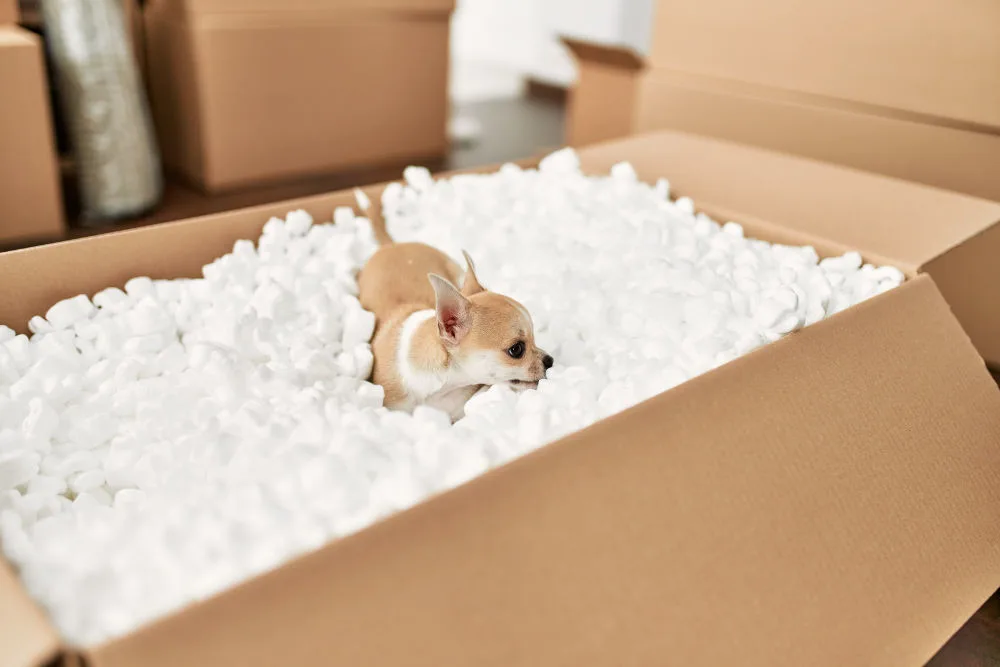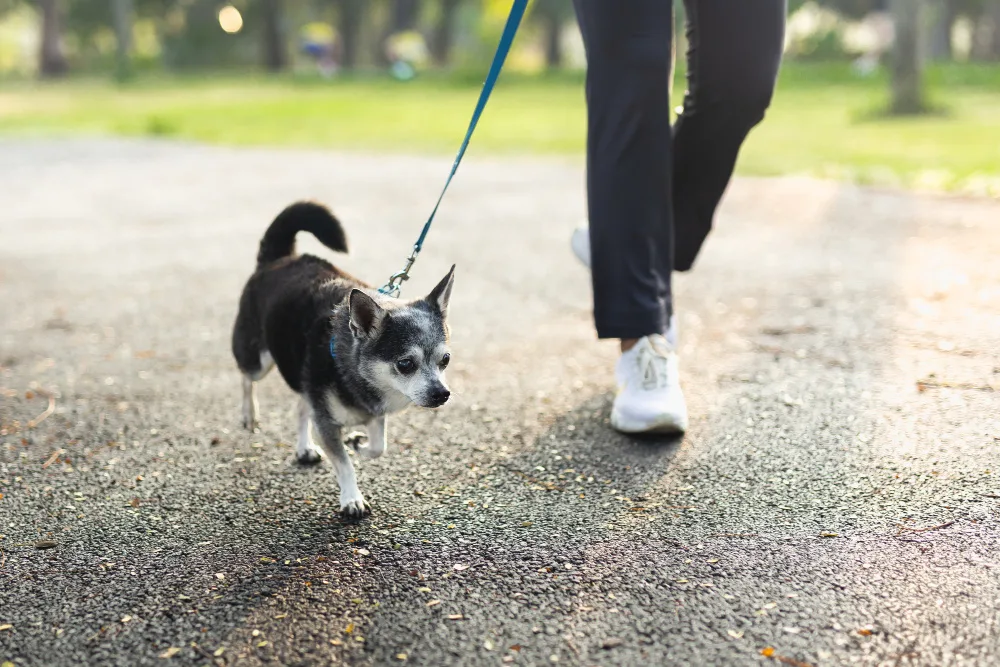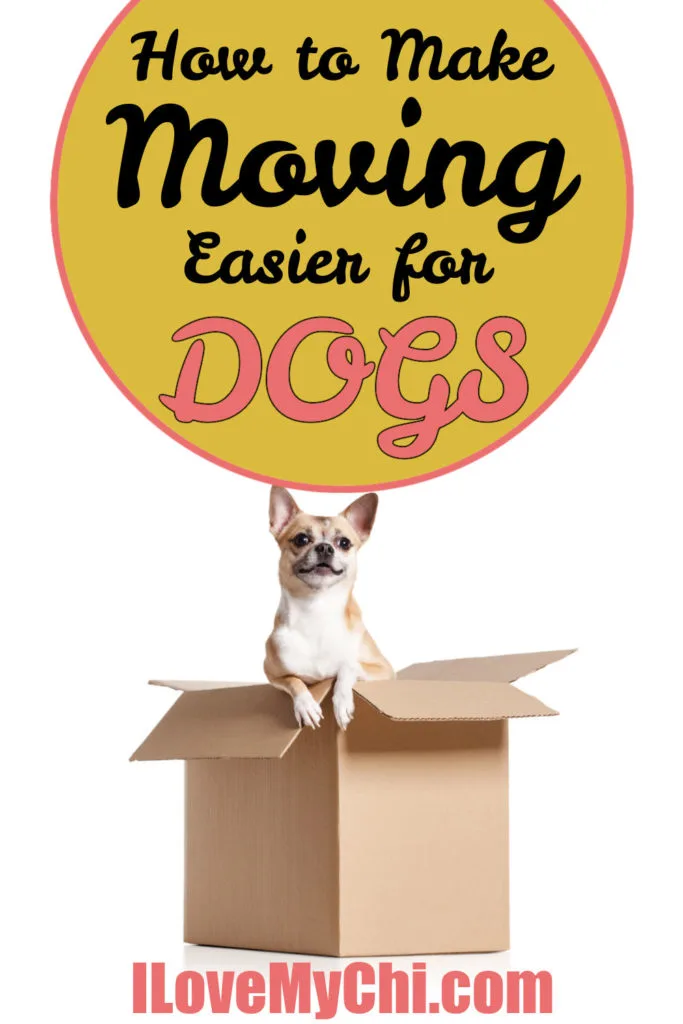Moving is easily one of the most stressful events in life for humans, who can understand what is happening. How much more stressful for a dog who doesn’t understand!
If you have a move upcoming, this article will provide information that may help you make moving easier for your dog.
Are Moves Stressful For Dogs?

Yes, moving is stressful for dogs. They cannot understand why their home changed. They were comfortable in their home, and to be removed from the scents, sights and sounds that they associated with safety can cause anxiety.
This anxiety can be displayed in many ways such as pacing, whining, having accidents in the house, struggling to sleep, hiding, refusing to eat, etc.
Keep in mind that your dog will likely struggle to adjust and will need your compassion during the move and the adjustment to their new home.
Arrange for your dog to babysat during the move.
If possible, have your dog be babysat to reduce their stress during the actual move. If there is a friend or relative that your dog is comfortable with, ask if they can spend moving day at this person’s home, then pick them up after the excitement as concluded.
If this is not an option, creating a quiet spot (described below) will be even more crucial.
Create a quiet spot.

Strange movers, loud sounds, and their home being torn apart can be stressful for a dog to experience. To combat this anxiety inducing event, create a quiet place for your dog to wait while your belongings and furniture are moved.
This quiet area will be a safe respite for your dog to spend time away from the hustle and bustle of the move. You will need one in both your former home and your new home.
Leave a room in your current home as a quiet spot during the move, then take your dog to the new home to the quiet spot there. Return to move the items from the quiet spot in the former home after the move is complete there.
If possible, move some small items and furniture into a room and set it up as closely to how it was in your former home as you are able to. If possible, set up this room for visits (described next) before moving day.
Your dog will likely rely on this quiet spot to feel safe as they adjust to their new home in the future as well, so plan to maintain it as is for at least six months.
Start by visiting.

If possible, take your dog to your new home a few times before you are scheduled to move in. Begin by walking around the yard and exterior of the home with your dog on a leash, then go inside and walk room by room on leash.
Return another time, then let your dog off leash in the home. Hang out for a little bit doing something that you normally do at your former home, such as eating a meal or reading a book, to help your dog associate this new place as a safe place to spend time. This helps your dog adjust to living in the new home.
If it is not possible to bring your dog inside the new home, go for walks in your new neighborhood as often as you are able to so that they can become familiar with their new territory.
If the weather does not permit for a walk, or before or after your walk, driving around the neighborhood is a fun way to help your dog become more comfortable with their new home if he or she enjoys car rides.
With the windows down and your dog safely secured so that he or she cannot jump out the window, drive down every street in your new neighborhood slowly to allow your dog to become accustomed to the sights, sounds, and scents in their new surroundings.
Stick to your routine.
Dogs thrive on their routines; during a time of major change in their lives, their routine becomes even more important. Sticking to the routine is a way to help ease your dog through the change by offering feelings of safety.
If you follow your dog’s routine as closely as possible, it can also speed up their becoming comfortable in the new home.
Exercise and entertain.
If your dog is provided exercise and mental stimulation, they will be able to better relax and settle into their new home. Daily walks, plus training and play sessions, will be crucial to keeping your dog happy through the transition.
Strategically arrange furniture.
If possible, arrange furniture as it was, or as similarly as you can, to how it was arranged in your previous home. This helps your dog feel more secure because it reminds him or her of the place they may still think of as home, as well as helping your dog understand the new house is now their home.
Do a housetraining refresh.

Expect to have a few accidents as your dog adjusts to their new surroundings, especially if other dogs resided in the home previously, leaving scents behind that your dog may feel the need to address.
Generally it is wise to help your dog through the transition with a house training refresh. Take your dog out every hour for the first few days. Thereafter, gradually increase the time between bathroom breaks, but be sure to offer a bathroom break shortly after a meal or drink.
Check fences.
If you have a fenced yard or access to a common area such as a dog park, thoroughly check the fence for any holes or weaknesses before allowing your dog off leash.
A dog escaping a yard in an unfamiliar area can quickly become a tragedy; he or she is likely to struggle with how to get home, lengthening their time loose, or not even return home at all.
Learn the layout of the new neighborhood.

Take your dog on a daily walk twice a day to help them learn the neighborhood so that if there is ever an accidental escape, he or she will know the way home. Walk the same route for a week, then walk a different route the second week. Focus on every possible route home in the neighborhood for a week at a time, then reset to the first route of focus, repeating until your dog seems to understand the way. A dog who understands the way home will lead you in the direction of home or not need to be directed.
Be flexible and patient.
Moving is stressful for everyone but especially dogs because they cannot understand what is happening. Be ready to be patient with your dog to help them through the transition of becoming comfortable in a new home. Remain flexible and prioritize your dog’s needs to make the transition smoother.
How Long Does It Take For A Dog To Adjust To A Move?

There is no one size fits all answer; just as humans are individuals, so are dogs, and as such, they all adjust differently.
Generally speaking, the first two weeks to a month are the hardest for a dog. By six months in the new home, your dog should likely become comfortable. If they are not, seek assistance from a dog trainer to help them with the adjustment.
Conclusion
No one likes moving, especially dogs because they are creatures of habit. By following the tips in this article, you may make moving less stressful for your dog.
Have you moved with your dog? Share your experience and any tips you may have learned in the comments below!



Vera
Friday 21st of June 2024
My two fur babies, Yoda and Chewie, have moved with me several times and most of the moves were international, involving planes, trains and automobiles! After reading your post, I feel truly lucky to have such wonderful and quick to adjust pups. Each move, whether it be domestic or international, has been smooth sailing with them. I do talk to them a lot throughout the process, explaining what's going and I give the extra love, hugs and kisses too. To them, wherever I am, that is home. I love them so much!!
Vera
Friday 28th of June 2024
@Cathy Bendzunas, Aww, thank you Cathy, that's so nice to hear from an awesome dog mom too!
Cathy Bendzunas
Sunday 23rd of June 2024
You are very lucky they have adjusted so well Vera but then you are an awesome dog mom.
Marie Cherf
Friday 1st of July 2022
Thank you Cathy for the moving advise . I did have the luxury of having 2 months to move . So I was able to bring them to the new house fairly regular . We have had a few accidents , but they had a doggie door at their old house , and we’ve yet to put one in here . I told my husband it’s not their fault . Thanks again .
Cathy
Saturday 2nd of July 2022
You are welcome Marie. It sounds like your move went fairly smoothly with your fur babies.